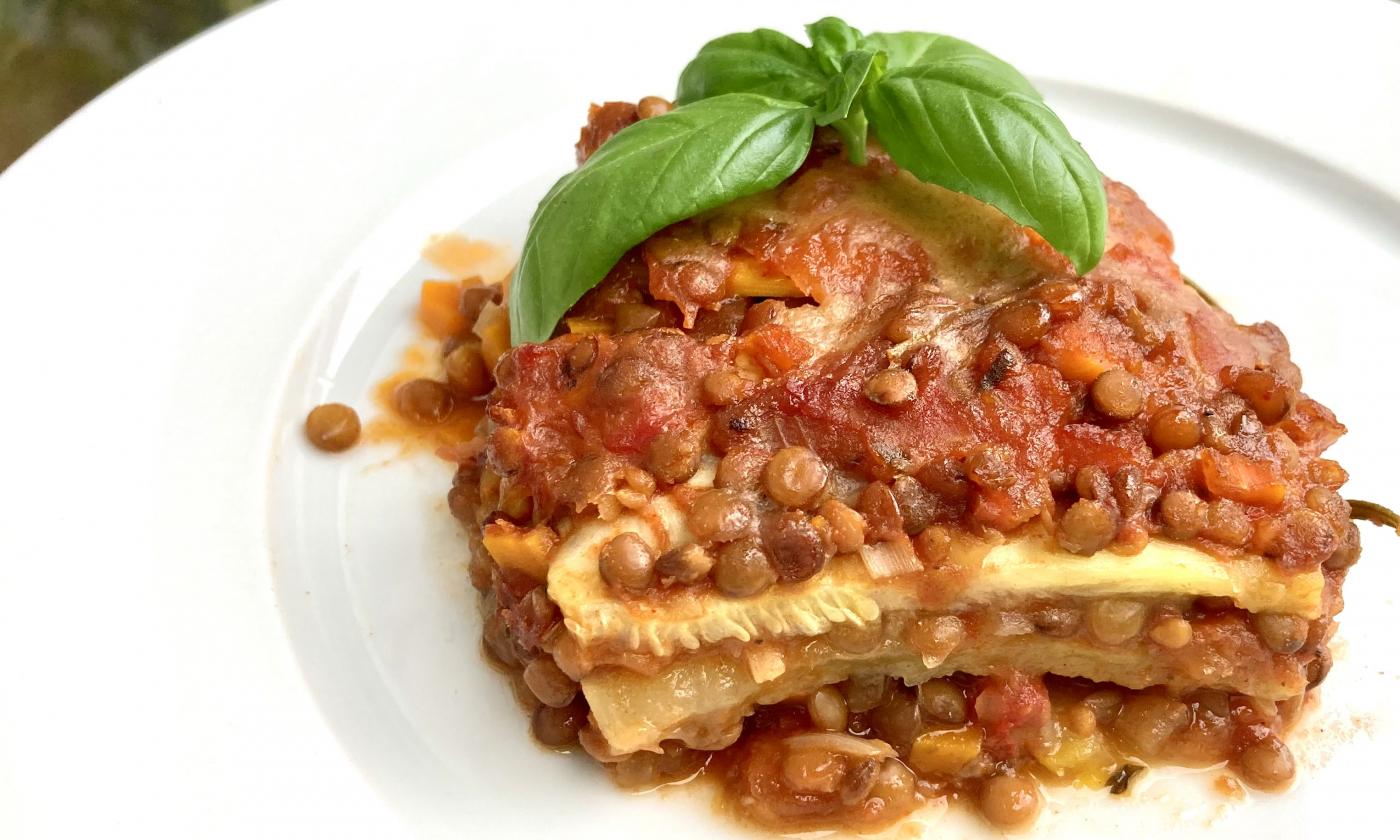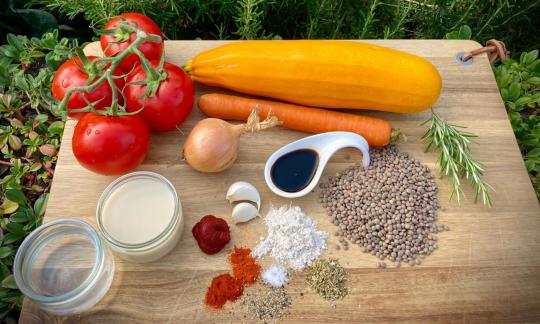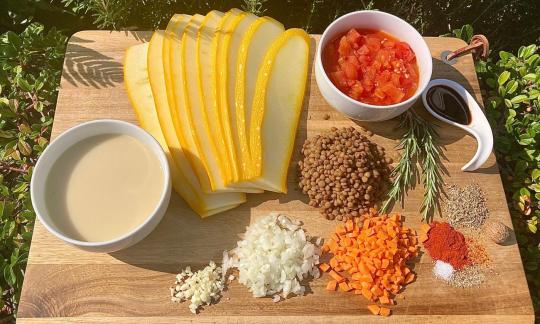Vegan oil-free zucchini lasagna with lentils
vegan
Ingredients (for servings, )
| For the basic structure | |
|---|---|
| 5 ¾ oz | Lentils (Erve, kitchen lentil), raw |
| 28 oz | Zucchini, raw, (organic?) |
| For the red sauce | |
| 28 oz | Tomatoes, raw (organic?) |
| 2 cloves | Garlic (organic?) (0.21 oz) |
| 1 large | Onions, raw (organic?) (5.3 oz) |
| 1 | Carrots (carrots), raw (organic?) (2.1 oz) |
| Optional ingredients | |
| 2 tbsp | Tomato paste, unsalted (organic?, raw?) (1.1 oz) |
| 2 tbsp | Balsamic vinegar (Aceto balsamico, raw?, organic?) (1.1 oz) |
| 70 ml | Drinking water, raw (organic?) (2.5 oz) |
| 2 sprigs | Rosemary, fresh (0.14 oz) |
| 1 tbsp | Paprika powder, hot (raw?, organic?) (0.24 oz) |
| 1 tbsp | Herbs of Provence (raw?, organic?) (0.13 oz) |
| 1 tbsp | Pimentón de la Vera (smoked paprika powder, organic?) (0.24 oz) |
| 1 tsp, ground | Black pepper (organic?, raw?) (0.08 oz) |
| 1 dash | Table salt (table salt, raw?, organic?) (0.01 oz) |
| For the white sauce | |
| 150 ml | Oat milk (oat drink, raw?, organic?) (5.3 oz) |
| ½ oz | Wheat flour, wholemeal (organic?) |
| 150 ml | Drinking water, raw (organic?) (5.3 oz) |
| 1 Msp. | Nutmeg, ground or grated (raw, organic?) (0.01 oz) |
Equipment
- vegetable peeler
- stove
- saucepan
- oven
- casserole dish (baking dish)
- sieve
Type of preparation
- cook
- bake
- chop or grind
- sweat
- season to taste
- deglaze
- remove the skin
- peel
- drain
- reduce (thicken)
- überbrühen
Preparation
Preparations - including red sauce ingredients
Put the lentils in a pan with three times the amount of water and cook with the lid on for about 20 minutes. Then put them in a sieve and drain. Remove the stalks from the tomatoes and pour boiling water over the tomatoes in a bowl. Peel the garlic and onion and chop finely. Peel the carrot and cut into small cubes.Lentils: The lentils should be cooked but still slightly firm after cooking. We used Pardina lentils ( brown lentils). These have the advantage that you don't have to soak them and the cooking time is still quite short at 20-30 minutes.
Peel and dice the scalded tomatoes (catch the water that comes out and use it later). Sauté the garlic and onions in a pan with a little water. Add the tomato paste (optional) and mix briefly. Then deglaze with balsamic vinegar, about 70 ml of water (for 4 people) and the diced tomatoes.
When sautéing, use just enough water to prevent the onions and garlic from sticking. Alternatively, you can use a tablespoon of refined rapeseed oil.
Add the pre-cooked lentils, rosemary and the other spices and season with salt, if available a little "herbs de Provence" (a herb mixture used in French cuisine) and hot paprika powder. Let the red sauce simmer for about 10-15 minutes. In the meantime, continue with the next step.
The amount of salt given is only a guide. Use only as little salt as necessary.
After cooking, remove the rosemary.For the light sauce
Pour about ¼ of the oat milk and water into a saucepan. Add 1 ½ tablespoons of wholemeal flour (for 4 people), mix in and bring to the boil. Stir regularly. Gradually add the rest of the oat milk and water and continue stirring until the sauce thickens. Season to taste with nutmeg, salt and pepper.The wholemeal flour gives the light sauce a slightly brownish color. The taste is a bit unusual on its own, but tastes very good in combination with the rest. You can also vary the sauce or leave it out completely (see "Alternative preparation").
For layering
Wash the zucchini (remove the peel on the long side if necessary) and cut lengthwise into slices about 0.3-0.4 cm thick.You can use both green and yellow zucchini.
If you have a very large zucchini from the garden, it is possible that the skin has become too hard. In this case, peel the skin thinly.Finishing the zucchini lasagna
Preheat the oven to about 190-200 °C. Use a coated oven dish (about 20x30 cm in size). Now start layering with some red sauce. Place the zucchini slices next to each other on top. First put red sauce on the zucchini slices and then some of the light sauce.
Repeat the layering until everything is used up (about 3 layers of zucchini) and finish with sauce.If you don't have a coated pan, you should grease the pan with a little refined rapeseed oil.
Place the zucchini lasagna on a rack in the lower third of the oven. Bake for about 30 minutes. The liquid should have evaporated enough at the end that you can easily portion the lasagna onto the plates.
|
Nutritional Information per person
Convert per 100g
|
2000 kcal | |
|---|---|---|
| Energy | 300 kcal | 15.0% |
| Fat/Lipids | 2.9 g | 4.1% |
| Saturated Fats | 0.56 g | 2.8% |
| Carbohydrates (inc.dietary fiber) | 57 g | 21.2% |
| Sugars | 18 g | 20.3% |
| Fiber | 12 g | 49.3% |
| Protein/Albumin | 17 g | 34.2% |
| Cooking Salt (Na:110.6 mg) | 281 mg | 11.7% |
| Essential micronutrients with the highest proportions | per person | 2000 kcal | |
|---|---|---|---|
| Vit | Vitamin B9, B11 (Folate, as the active form of folic acid) | 298 µg | 149.0% |
| Vit | Vitamin C (ascorbic acid) | 71 mg | 89.0% |
| Min | Manganese, Mn | 1.8 mg | 88.0% |
| Elem | Potassium, K | 1'574 mg | 79.0% |
| Vit | Vitamin B6 (pyridoxine) | 0.92 mg | 66.0% |
| Min | Copper, Cu | 0.65 mg | 65.0% |
| Prot | Threonine (Thr, T, irreversibly transaminated) | 0.57 g | 62.0% |
| Prot | Tryptophan (Trp, W) | 0.15 g | 60.0% |
| Vit | Vitamin B1 (Thiamine) | 0.64 mg | 58.0% |
| Prot | Lysine (Lys, K, irreversibly transaminated) | 1.0 g | 54.0% |
Detailed Nutritional Information per Person for this Recipe
The majority of the nutritional information comes from the USDA (US Department of Agriculture). This means that the information for natural products is often incomplete or only given within broader categories, whereas in most cases products made from these have more complete information displayed.
If we take flaxseed, for example, the important essential amino acid ALA (omega-3) is only included in an overarching category whereas for flaxseed oil ALA is listed specifically. In time, we will be able to change this, but it will require a lot of work. An “i” appears behind ingredients that have been adjusted and an explanation appears when you hover over this symbol.
For Erb Muesli, the original calculations resulted in 48 % of the daily requirement of ALA — but with the correction, we see that the muesli actually covers >100 % of the necessary recommendation for the omega-3 fatty acid ALA. Our goal is to eventually be able to compare the nutritional value of our recipes with those that are used in conventional western lifestyles.
| Essential fatty acids | per person | 2000 kcal |
|---|---|---|
| Alpha-Linolenic acid; ALA; 18:3 omega-3 | 0.21 g | 10.0% |
| Linoleic acid; LA; 18:2 omega-6 | 0.86 g | 9.0% |
| Essential amino acids | per person | 2000 kcal |
|---|---|---|
| Threonine (Thr, T, irreversibly transaminated) | 0.57 g | 62.0% |
| Tryptophan (Trp, W) | 0.15 g | 60.0% |
| Lysine (Lys, K, irreversibly transaminated) | 1.0 g | 54.0% |
| Isoleucine (Ile, I) | 0.65 g | 52.0% |
| Phenylalanine (Phe, F) | 0.74 g | 48.0% |
| Valin (Val, V) | 0.75 g | 47.0% |
| Leucine (Leu, L) | 1.1 g | 44.0% |
| Methionine (Met, M) | 0.16 g | 17.0% |
| Vitamins | per person | 2000 kcal |
|---|---|---|
| Vitamin B9, B11 (Folate, as the active form of folic acid) | 298 µg | 149.0% |
| Vitamin C (ascorbic acid) | 71 mg | 89.0% |
| Vitamin B6 (pyridoxine) | 0.92 mg | 66.0% |
| Vitamin B1 (Thiamine) | 0.64 mg | 58.0% |
| Vitamin K | 36 µg | 49.0% |
| Vitamin A, as RAE | 283 µg | 35.0% |
| Vitamin B7 (Biotin, ex vitamin H) | 16 µg | 31.0% |
| Vitamin B5 (Pantothenic acid) | 1.7 mg | 29.0% |
| Vitamin B2 (Riboflavin) | 0.38 mg | 27.0% |
| Vitamin B3 (Niacin) | 4.2 mg | 26.0% |
| Vitamin E, as a-TEs | 2.7 mg | 23.0% |
| Essential macroelements (macronutrients) | per person | 2000 kcal |
|---|---|---|
| Potassium, K | 1'574 mg | 79.0% |
| Phosphorus, P | 306 mg | 44.0% |
| Magnesium, Mg | 106 mg | 28.0% |
| Calcium, Ca | 115 mg | 14.0% |
| Sodium, Na | 111 mg | 14.0% |
| Essential trace elements (micronutrients) | per person | 2000 kcal |
|---|---|---|
| Manganese, Mn | 1.8 mg | 88.0% |
| Copper, Cu | 0.65 mg | 65.0% |
| Iron, Fe | 5.7 mg | 41.0% |
| Zinc, Zn | 2.9 mg | 29.0% |
| Selenium, Se | 3.7 µg | 7.0% |
| Iod, I (Jod, J) | 5.1 µg | 3.0% |
| Fluorine, F | 49 µg | 1.0% |
The vegan oil-free zucchini lasagna with lentils does not require any pasta sheets and can be prepared without much prior knowledge.
Nutrient profile: With just under 280 kcal per portion, the recipe is a low-calorie alternative to traditional lasagne. According to GDA guidelines, one portion of this dish covers over 100% of the daily requirement of folic acid and about ¾ of that of vitamin C. The daily requirement of manganese is covered by ¾. The proportion of essential omega-6 and omega-3 fatty acids in this dish is negligible, even if the ratio of 4:1 is below the maximum recommended ratio of 5:1. More on this under: Vegans often eat unhealthily. Avoidable nutritional errors. The salt content is in a good range for a main course. If you prefer a particularly low-salt diet, you can also reduce the amount of salt.
Zucchini: Zucchini is versatile in terms of its use (can also be eaten raw). In addition to the classic green zucchini, yellow zucchini is also increasingly available. However, they taste almost identical, which is why you can use both forms for this dish. Zucchini is easy to digest, low in calories and rich in vitamins. Be careful with bitter-tasting zucchini. The bitter taste is caused by the poisonous bitter substances cucurbitacins. These cannot be destroyed by cooking and attack the stomach and intestinal mucosa. An increased content of bitter substances can arise, especially when grown at home (by backcrossing home-grown seeds or crossing with other pumpkin plants).
Lentils: Because of their high-quality proteins, lentils are a very good source of plant-based protein for vegans. You should be aware, however, that they only contain a relatively small amount of the essential amino acid methionine, for example, which is why combining them with rice or beans can compensate for this in some dishes. The different types of lentils, which are all round and flat, differ in size and color. The Pardina lentil, which we use in this dish, has a gray-brown shell and a yellow interior. It has been cultivated in northern Spain for more than 800 years. Here, this type of lentil is also known as brown lentil. It is often confused with plate lentils, which look similar but are larger. Pardina lentils do not need to be soaked beforehand. The cooking time is 20-30 minutes. This can be reduced to 10-15 minutes by using a pressure cooker.
This dish is perfect if you have your own zucchini in the garden and need new recipe ideas
Reduce salt and oil: We have deliberately left out oil for health reasons. You can also reduce the amount of salt as needed. You can find more information on this topic in the book we describe in detail: "Salt Sugar Fat" by Michael Moss.
Light sauce: You can use wheat flour type 550 or rice flour instead of wholemeal flour for the light sauce. If you use the latter, you will need to simmer the sauce for about 5 minutes until it thickens. You can also season the sauce with yeast flakes, 1 teaspoon of mustard and a dash of lemon juice. Alternatively, you can leave out the light sauce altogether. In that case, however, you will need a little more of the red sauce. To do this, either add additional tomato paste and water, or add tomatoes and season to taste.
Shorten the preparation time: You can also use chopped tomatoes from a can or jar instead of fresh tomatoes.
Seasoning: If you like it a little spicy, you can season the red sauce with some chili powder.
Make your own oat milk: You can find a recipe for making your own oat milk at the following link.








